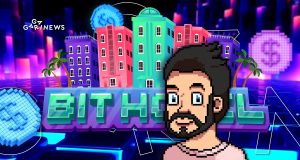What is TerraClassicUSD (USTC)? An overview of the project

TerraClassicUSD (USTC) is an algorithmic stablecoin of the Terra blockchain. The idea behind USTC was to tackle the scalability issues that plagued other stablecoins. However, USTC ultimately proved to be the downfall of the Terra ecosystem in May 2022.
On this page
The project’s mission
Launched in 2019, Terra aimed to speed up the adoption of cryptocurrencies and provide an optimal environment for dApp developers through a decentralized open-source blockchain protocol.
Its founders are Do Kwon, a former software engineer at Apple and Microsoft, and a CEO of Anyfi startup, and Daniel Shin, an economist, and a co-founder of Fast Track Asia and e-commerce platform TMON.
Terra was designed to be a prime platform for stablecoins pegged to fiat currencies and decentralized app development. However, in May 2022, the ecosystem crashed as TerraUSD lost its dollar peg. The exact causes of the disaster remain unknown. Soon after, Do Kwon withdrew from public appearances, while remaining active on Twitter. A co-founder of Terraform Labs said that he was not evading investigation and was willing to cooperate.
As of writing, Do Kwon, who had been on the run for a while, has been arrested in Montenegro and is awaiting trial in prison. On the other hand, a South Korean court turned down an arrest warrant against Daniel Shin.
Features of the Terra blockchain
The Terra blockchain is designed for creating fiat-backed stablecoins through the network's seigniorage. It utilizes the Delegated Proof-of-Stake (DPoS) consensus algorithm.
The project quickly gained popularity in Asia and later expanded to European countries and the United States. Apart from the TerraUSD stablecoin pegged to the US dollar (now known as TerraClassicUSD), the platform also offered stablecoins pegged to the euro, Mongolian tugrik, South Korean won, and other currencies.
Terra's fiat pegging mechanism was different from that of other stablecoins. The platform used algorithms instead of actual dollar reserves to manage stablecoins and maintain their pegs. Terra's stablecoins were directly linked to the blockchain's native cryptocurrency, called LUNA (now known as LUNA Classic or LUNC).
The developers positioned LUNA as a tool to protect stablecoins from volatility. The system used the cryptocurrency to determine the value of stablecoins and acted as a counterparty for users who wanted to exchange stablecoins for LUNA and vice versa.
To maintain the stability of the TerraUSD exchange rate, the platform employed two basic algorithms:
- When the demand for the stablecoin increased, the speed of burning LUNA tokens and minting UST tokens increased.
- When the demand for the stablecoin decreased, the burning of LUNA tokens slowed down and the minting of UST tokens intensified.
The development of algorithmic stablecoins made the system model more scalable and accessible compared to competing projects.
Key details about TerraClassicUSD (USTC)
The purpose
TerraClassicUSD (USTC) is an algorithmic stablecoin that was launched by the original Terra blockchain in 2020 under the name TerraUSD (UST). As mentioned earlier, the stablecoin was not backed by real dollar reserves. The value of TerraUSD (UST) was controlled by algorithms that burned and minted LUNA
The platform offered several ways to use the stablecoin:
- Earning passive income. To do this, the Anchor savings protocol with a fixed interest rate was launched on the Terra blockchain. Users who locked their assets in a liquidity pool for a certain period of time were guaranteed a passive income of 20% of the initial amount.
- Exchange for other stablecoins within the system with minimal fees.
- Trading. Some cryptocurrency exchanges offered trading pairs with TerraUSD (UST).
- Online payments. The stablecoin could be used as a payment method to pay for goods and services or transfer funds to cryptocurrency wallets of recipients anywhere in the world.
Supply
As of April 2023, the circulation supply of TerraClassicUSD is 9,799,695,581 coins, with the maximum circulating supply being unlimited.
How TerraUSD (UST) became TerraClassicUSD (USTC)
TerraUSD (UST) was once considered one of the largest algorithmic stablecoins. However, in May 2022, it unexpectedly lost its peg to the US dollar. On May 9th, the UST rate dropped to $0.68 with no explanation for the reasons or possible prospects of the coin.
As a result of the rate drop, users began withdrawing UST liquidity from the Anchor Protocol, exchanging and cashing out the stablecoin. In an attempt to stabilize the situation, the platform activated LUNA minting. Unfortunately, the cryptocurrency fell into a hyperinflationary spiral and lost more than 95% of its value.
Despite efforts to save TerraUSD (UST), such as selling $1.5 billion worth of Bitcoin owned by the platform and burning LUNA to reduce circulating supply, the ecosystem continued to suffer.
In a bid to revive the project, the co-founders initiated a community-led effort that resulted in the creation of a new blockchain called Terra Classic. As a result, TerraUSD (UST) was rebranded as TerraClassicUSD (USTC) and LUNA was renamed LUNA Classic (LUNC).
The new Terra blockchain, also known as Terra 2.0, is primarily focused on dApps and is community-owned with no involvement from Daniel Shin and Do Kwon. Algorithmic stablecoins have been excluded from the Terra 2.0 structure, with the sole cryptocurrency of the project being Terra (LUNA).
Current market situation
According to data from coinmarketcap.com, as of the time of writing, TerraClassicUSD (USTC) is ranked 155th among virtual currencies by market capitalization. The circulating supply of USTC is 9,799,706,690. The coin is currently trading at $0.02175, with a market capitalization of $213,128,588 and a daily trading volume of $7,803,844.
The content on The Coinomist is for informational purposes only and should not be interpreted as financial advice. While we strive to provide accurate and up-to-date information, we do not guarantee the accuracy, completeness, or reliability of any content. Neither we accept liability for any errors or omissions in the information provided or for any financial losses incurred as a result of relying on this information. Actions based on this content are at your own risk. Always do your own research and consult a professional. See our Terms, Privacy Policy, and Disclaimers for more details.


























